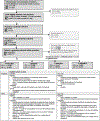Centralized Reminder/Recall to Increase Influenza Vaccination Rates: A Two-State Pragmatic Randomized Trial
- PMID: 31698085
- PMCID: PMC7477488
- DOI: 10.1016/j.acap.2019.10.015
Centralized Reminder/Recall to Increase Influenza Vaccination Rates: A Two-State Pragmatic Randomized Trial
Abstract
Objective: Centralized reminder/recall (C-R/R) by health departments using immunization information systems is more effective and cost effective than practice-based approaches for increasing childhood vaccines but has not been studied for influenza vaccination. We assessed effectiveness and cost of C-R/R for increasing childhood influenza vaccination compared with usual care.
Methods: Within Colorado (CO) and New York (NY), random samples of primary care practices (pediatric, family medicine, and health center) were selected proportionate to where children are served-65 practices (N = 54,353 children) in CO; 101 practices (N = 65,777) in NY. We conducted 4-arm RCTs per state (1, 2, or 3 autodial reminders vs usual care), with randomization at the patient level within practices from 10/2016 to 1/2017.
Results: In CO, the maximum absolute difference in receipt of ≥1 influenza vaccine was 1.7% between the 2 R/R group and control (adjusted risk ratio [ARR] of 1.06 [1.01, 1.10]); other R/R arms did not differ significantly. In NY, ARRs for the study arms versus control varied from 1.05 (1.01, 1.10) for 3 R/R to 1.06 (1.01, 1.11) for 1-2 R/R groups and maximum absolute increase in vaccination was 0.6%. In time-to-event analyses, study arm was a significant predictor of vaccination in CO (P = .001) but not in NY. Costs/child randomized to one message were $.17 in CO and $.23 in NY.
Conclusions: C-R/R for influenza vaccine using autodial had low-level effects on increasing influenza rates in 2 states. Given the feasibility and low cost of C-R/R in previous trials, its utility for influenza should be re-examined using different modalities.
Trial registration: ClinicalTrials.gov NCT02761551 NCT02924467.
Keywords: centralized reminder/recall; influenza vaccine; pediatrics; population-based reminder/recall.
Copyright © 2019 Academic Pediatric Association. Published by Elsevier Inc. All rights reserved.
Figures


Similar articles
-
Centralized Reminder/Recall for Human Papillomavirus Vaccination: Findings From Two States-A Randomized Clinical Trial.J Adolesc Health. 2021 Oct;69(4):579-587. doi: 10.1016/j.jadohealth.2021.02.023. Epub 2021 Apr 10. J Adolesc Health. 2021. PMID: 33846054 Free PMC article. Clinical Trial.
-
Effect of State Immunization Information System Based Reminder/Recall for Influenza Vaccinations: A Randomized Trial of Autodialer, Text, and Mailed Messages.J Pediatr. 2020 Jun;221:123-131.e4. doi: 10.1016/j.jpeds.2020.02.020. J Pediatr. 2020. PMID: 32446470 Free PMC article. Clinical Trial.
-
Potential Strategies to Achieve Universal Influenza Vaccination for Children: Provider Attitudes in Two States.Acad Pediatr. 2018 Nov-Dec;18(8):873-881. doi: 10.1016/j.acap.2018.07.003. Epub 2018 Jul 19. Acad Pediatr. 2018. PMID: 30031132 Free PMC article.
-
Effect of patient reminder/recall interventions on immunization rates: A review.JAMA. 2000 Oct 11;284(14):1820-7. doi: 10.1001/jama.284.14.1820. JAMA. 2000. PMID: 11025835 Review.
-
Increasing Influenza Vaccination Rates in People With Chronic Illness.Dtsch Arztebl Int. 2019 Sep 27;116(39):645-652. doi: 10.3238/arztebl.2019.0645. Dtsch Arztebl Int. 2019. PMID: 31617479 Free PMC article.
Cited by
-
Effect of Patient Portal Reminders Sent by a Health Care System on Influenza Vaccination Rates: A Randomized Clinical Trial.JAMA Intern Med. 2020 Jul 1;180(7):962-970. doi: 10.1001/jamainternmed.2020.1602. JAMA Intern Med. 2020. PMID: 32421168 Free PMC article. Clinical Trial.
-
Staff and caregivers' perceptions of digital storytelling to increase influenza vaccine confidence in an urban safety-net healthcare system.Vaccine. 2025 Jan 25;45:126572. doi: 10.1016/j.vaccine.2024.126572. Epub 2024 Dec 15. Vaccine. 2025. PMID: 39681021
-
Mobile Phone Text Message Reminders to Improve Vaccination Uptake: A Systematic Review and Meta-Analysis.Vaccines (Basel). 2024 Oct 8;12(10):1151. doi: 10.3390/vaccines12101151. Vaccines (Basel). 2024. PMID: 39460318 Free PMC article. Review.
-
Centralized Reminder/Recall for Human Papillomavirus Vaccination: Findings From Two States-A Randomized Clinical Trial.J Adolesc Health. 2021 Oct;69(4):579-587. doi: 10.1016/j.jadohealth.2021.02.023. Epub 2021 Apr 10. J Adolesc Health. 2021. PMID: 33846054 Free PMC article. Clinical Trial.
-
A scoping review protocol on childhood immunization reminder strategies available to parents in Canada and the United States of America.PLoS One. 2025 May 22;20(5):e0323186. doi: 10.1371/journal.pone.0323186. eCollection 2025. PLoS One. 2025. PMID: 40403040 Free PMC article.
References
-
- Prevention and control of seasonal influenza with vaccines. Recommendations of the Advisory Committee on Immunization Practices--United States, 2013–2014. MMWR Recommendations and reports : Morbidity and mortality weekly report Recommendations and reports. 2013;62(Rr-07):1–43. - PubMed
-
- Poehling KA, Edwards KM, Weinberg GA, et al. The Underrecognized Burden of Influenza in Young Children. New England Journal of Medicine. 2006;355(1):31–40. - PubMed
-
- Neuzil Kathleen M, Zhu Y, Griffin Marie R, et al. Burden of Interpandemic Influenza in Children Younger than 5 Years: A 25‐Year Prospective Study. The Journal of Infectious Diseases. 2002;185(2):147–152. - PubMed
-
- Fiore AE, Shay DK, Broder K, et al. Prevention and control of influenza: recommendations of the Advisory Committee on Immunization Practices (ACIP), 2008. MMWR Recommendations and reports : Morbidity and mortality weekly report Recommendations and reports. 2008;57(Rr-7):1–60. - PubMed
-
- Office of Disease Prevention and Health Promotion. Healthy People 2020. Increase the percentage of children aged 6 months through 17 years who are vaccinated annually against seasonal influenza Web site. https://www.healthypeople.gov/node/6359/data_details#revision_history_he.... Published 2018. Accessed November 14, 2017.
Publication types
MeSH terms
Substances
Associated data
Grants and funding
LinkOut - more resources
Full Text Sources
Medical

